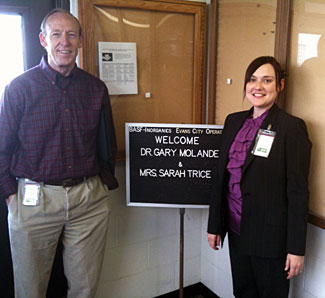In the grand scheme of things, a tiny molecule can mean a lot—especially in Penn Chemistry’s High Throughput Experimentation Laboratory. The state-of-the-art laboratory is capable of testing hundreds of reactions a day, as opposed to only a handful previously. It is here that doctoral student Sarah Trice and Hirschmann-Makineni Professor of Chemistry Gary Molander of the Department of Chemistry developed a new type of reagent that allows for easier synthesis of boronic acids, one of the main ingredients needed to perform a Suzuki-Miyaura cross-coupling reaction—the most efficient way to create carbon-carbon bonds in critical biaryl systems.
The project began with a clear goal: to replace bis(pinacolato)diboron (BisPin), the tried and tested synthesizing reagent for many pharmaceutical building blocks, with a more efficient material. Because of BisPin’s molecular weight, almost 90 percent of the reagent is wasted each time it is used for a coupling. This amounts to a staggering 10 tons of pinacol discarded per year. Trice and Molander’s bis-boronic acid is not only lightweight, but incorporates nearly 50 percent of the needed mass into the final molecule. In addition, the method utilizes one of the rare drinkable solvents—ethanol, as opposed to an ether solvent—and wastes far less palladium catalyst than traditional methods.
“It’s like Legos. You’ve got one building block, say your red Lego—that’s your boronic acid. And you’ve got a blue Lego, your aryl halide,” says Steven Kennedy, a postdoctoral research associate that later joined Trice and Molander to explore the scope of the project. “The new reagent allows for “one-pot” generation, essentially snapping the two “Legos” together in a single go, all while avoiding the time-consuming practice of isolating the intermediate boronic acid, or the need to purchase an expensive, wasteful, pre-made boronic acid.”
Trice and Molander’s method quickly found an audience. Their paper was published in the Journal of the American Chemistry Society, one of the preeminent chemistry journals. And though their method had gained popularity in the community, and could ostensibly improve cost and production efficiency markedly for pharmaceutical companies, they decided not to patent the reaction.
“If you patent something, people won’t use it. They’ll find a way around it, or revert back to the old, archaic method,” says Trice. "Dr. Molander wanted to allow access to everyone because he feels that it is more efficient, environmentally-friendly and solves many of the problems associated with using the standard BisPin.”
Trice and Kennedy are currently working on further improvements to the reaction. Previously, with the older reagent BisPin, temperatures would need to reach 110 degrees Celsius, a potentially dangerous situation given that ethereal solvents can be explosive. With Trice and Molander’s bis-boronic acid, however, temperatures are holding between 50-80 degrees Celsius, a number they think they can improved upon, which would allow for a less volatile production environment.
There is an artistic elegance in the reaction, as well, says Trice. “My favorite aspect is that it changes color after it borylates, so you don’t need to use an analytical instrument to say, ‘Oh, it’s done now.’ After that, you just add the second reagent and you’re off to do your coupling. My colleague was in the laboratory next to us and she couldn’t believe her eyes—it’s a terrific perk.”



